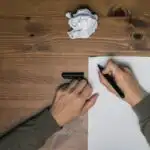As children begin to learn how to use language, it’s our job to empower them with as much information as possible to allow them to become confident communicators.
As teachers and parents, we want our children to be able to read, write, and speak confidently and clearly, so educating them on the various aspects of language at the right time is essential.

One of the building blocks when teaching children phonemic awareness is getting them to understand digraphs.
In this guide, we’ll recap what a digraph is and share some ways that you can help children understand them better.
What Is A Digraph?
A digraph consists of a pair of letters that combine to make a different sound in spoken or written English.
These letters pair, such as “ch” in “chair” or “th” in “think”, to create sounds that aren’t necessarily intuitive from the individual letters themselves.
There are consonant digraphs and vowel digraphs – it’s estimated that there are 50 vowel digraphs and 75 consonant digraphs in the English language.
Common Digraph Examples
As we said, there are consonant and vowel digraphs – so we will break them down into the two groups below:
Common Consonant Digraphs
These are some of the most well-known consonant digraphs:
- CH: As in ‘chair’ or ‘child’
- PH: As in ‘phone’ or ‘graph’
- TH: As in ‘teeth’ or ‘think’
- WH: As in ‘what’ or ‘where’
- GH: As in ‘ghost’ or ‘laugh’
- SH: As in ‘push’ or ‘wish’
- SS: As in ‘class’ or ‘press’
- CK: As in ‘cluck’ or ‘chicken’
- KN: As in ‘knee’ or ‘knock’
- NG: As in ‘king’ or ‘sing’
Common Vowel Digraphs
Some of the most common vowel digraphs include:
- EA: As in ‘beach’ or ‘dream’
- AI: As in ‘rain’ or ‘brain’
- EY: As in ‘hey’ or ‘they’
- IE: As in ‘pie’ or ‘tie’
- OE: As in ‘toe’ or ‘doe’
- OW: As in ‘snow’ or ‘low’
- UI: As in ‘fruit’ or ‘juice’
- OO: As in ‘moon’ or ‘book’
- UE: As in ‘blue’ or ‘glue’
- EE: As in ‘free’ or ‘tree’
- OA: As in ‘boat’ or ‘float’
What Are Split Digraphs?
Now we know the basics of digraphs, let’s take a look at split digraphs.
Split digraphs are sometimes referred to as “magic e” or “silent e” in elementary education.
They involve two letters that work together to produce a particular sound, even though they are separated by another letter in the word.
Typically, a split digraph consists of a vowel, followed by a consonant, and then an “e” at the end.
The “e” is “silent,” but it works together with the preceding vowel to change the sound of the word.
For example:
- I-E: As in ‘fine’ or ‘pine’
- A-E: As in ‘plane’ or ‘same’
- O-E: As in ‘stone’ or ‘hope’
- E-E: As in ‘theme’ or ‘sphere’
- U-E: As in ‘cube’ or ‘tube’
The concept of the split digraph is instrumental in teaching young readers about vowel sounds and word patterns in the English language.

Strategies For Teaching Digraphs To Children
When teaching digraphs to children, you can have a lot of fun and practice different methods to find out what works best for different students.
Here are some of our favorite methods for teaching digraphs:
1. Flashcards
Flash cards are an excellent teaching method, and they can be applied to a variety of lessons.
In this instance, by using flashcards, you can add a digraph on one side and a picture relating to it on the other to help children understand how it’s used.
2. Digraph Sorting
On tiles or pieces of paper, you can add a variety of different words that contain different digraphs and ask children to work together to sort them into groups of matching digraphs.
3. Songs And Chants
Songs and chants work well to help most children learn. To teach them digraphs, you can use many of the songs or chants available online and teach them to your class.
Or, for something even more interactive, you can make one up with your students.
4. Anchor Charts
Hang digraph anchor charts around the classroom that contain examples to help children learn.
5. Bingo
Children love a game in the classroom, and bingo is a great one to help them learn digraphs.
Place digraph words into a tub and prepare bingo sheets for the children. As you call out each digraph, have them mark them off and see who can get a full house first.
6. Books With Digraphs
If you’re teaching digraphs to your students, try to incorporate this learning into storytime by choosing books that are full of them.
Hearing digraphs in the context of a story can help with the learning process.
7. Whiteboards
Children love the opportunity to draw on whiteboards, and this can be a great method for helping them to understand digraphs.
Call students up to the board, one by one, give them a colored whiteboard marker, and have them practice writing a word with their favorite digraph.
8. Tiles Or Magnets
Using tiles or magnets with letters on them, you can ask your students to create different words that contain digraphs.
9. Word Searches
Word searches are great fun and easy to make for the classroom.
There are tons of digraph word searches available online, or you can make your own.
10. Real-Life Examples
Children can benefit from having real-life examples when learning new concepts, and this can also be applied to digraphs.
By looking around the classroom, you can ask them to call out items that have digraphs in their names.
For example, they may be able to spot a lunchbox (‘ch’ digraph) or some string (‘ng’ digraph).
11. Story Writing
Finally, get your students to unleash their creativity and create stories that specifically relate to digraphs.
For example, a short story about the mouse (‘ou’) that saw snow (‘ow’) for the first time would be great fun.
In Summary
We’ve refreshed our memories on what digraphs are, and we’ve looked at vowel, consonant, and split digraphs in this article.
There are many methods for teaching digraphs to children, but some of our favorites include flash cards, story writing, songs, and playing bingo.
Find the method that’s best for you and the children you’re working with, or invent something completely new.
Further reading: Teaching Ethos, Pathos and Logos.
- Homeschooling In High School: Pros And Cons - February 24, 2024
- How Do I Withdraw My Child From School To Homeschool? - February 23, 2024
- How To Not Go Crazy Homeschooling Kids: A Guide For Frazzled Parents - February 22, 2024









Leave a comment